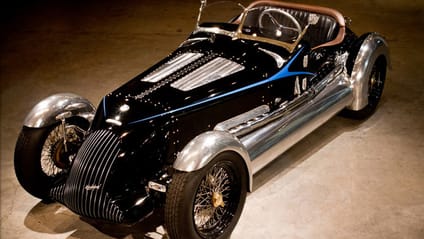
The gas-burning Magnolia Roadster
Revealed: this is how to build a very cool, very green and very vintage car


You're currently staring at the world's first hand-built car to run on compressed natural gas (If you've watched James' Honda Clarity film, you'll remember we = like gas as a potential fuel source - albeit hydrogen for the Clarity) and it's called the Magnolia Special.
The engine's based on the E-Type's 4.2-liter six-pot, but emits 40 per cent less CO2 than the original. It's still fast, though: it makes 200bhp and 300lb ft. Considering its 1224kg mass, that's a torque-to-weight ratio to trump Porsche's new 911.
Nice, but why? Its creator and designer, New Orlean's-based motorbike builder, J.T. Nesbitt, says: "I want to produce a long-distance endurance racecar that extols the virtues of clean burning fuel." He adds, "The Magnolia Special will embark on a run from New York to Los Angeles."
Which, in Top Gear speak, means "for fun."
Click on to see it being built.
Advertisement - Page continues below
In 2008, Nesbitt built a scale model of his dedicated compressed natural gas (CNG) car to figure out aesthetics and how to incorporate large carbon-wrapped alloy fuel tanks into the chassis.

Construction began in September 2009, starting with the chassis - a bespoke, box section steel number was fabricated that placed the powertrain for 47% front and 53% rear weight distribution.
Advertisement - Page continues below
The six cylinder Jag engine was chosen for its torqueyness at low RPMs. CNG's got an octane rating equivalent to 130 so high compression 12.5:1 pistons were specially forged. There are also spiky high-lift, short-duration cams.

The engine's hooked up to a five-speed gearbox with a 3.00 gear ratio - that allows it to run at high road speeds and low engine rpms. It's hiding under this alloy floor panel.

Rear suspension's made up a four-link setup, Panhard rod and set of adjustable coil-over shocks. Check out the hinge detailing.

Up front, there's a pushrod-actuated inboard coil-over shock setup with double wishbones and rack and pinion steering. There's discs all-round with alloy calipers, too.
Advertisement - Page continues below
And LOOK at that bulkhead.

The fuel tanks, which are carbon-wrapped alloy, add strength to the alloy chassis. The burst pressure's 4,800 PSI, but they'll normally be filled to 3,600 PSI.
Advertisement - Page continues below
The alloy clap-bonnet takes shape.

Nesbitt used these fasteners so you can remove the bodywork and access the chassis for repairs. They also look rather lovely.

All the instruments are bespoke and attached to a robust, modern wiring loom.

Now we're getting to the cool stuff - the hinges, knobs, and badges were cast using traditional mould-and-sand techniques.

The door handles, bonnet latches, luggage rack and other fixtures were fabricated from 316 stainless steel. Some stuff got some extra frills, like the hand-tooled leather steering wheel.

In spring this year, the body was prepared for paint and upholstered to create this. Later this year, it'll leave on a trans-American run from New York to Los Angeles.

Nesbitt says: "Every engineering decision has been inspired by the desire to produce a long-distance endurance racecar that extols the virtues of a clean burning domestic fuel."

"Aesthetic considerations have been applied with regional influences taking precedent."

"She has been born in New Orleans and it is our wish to imbue our prototype with the beauty of Louisiana, in honor of our namesake on whose shoulders we stand." Pretty cool, no?
Trending this week
- Car Review
BMW 1 Series







